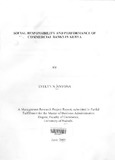| dc.description.abstract | Fertility determinants has been receiving some attention in the recent past. This is particularly so in countries where the rate of population growth are high.The objective of this study was to look into the factors that determine fertility attitude and outcome using additional children wanted and children ever born (CEB) as dependent variables
respectively. The emphasis of the study was on the influence of direct infant/child loss on CEB and attitude. other variables considered included educational levels, duration of marriage,residence, age and living children.The data used in the study was from the Kenya Fertility Survey (KFS) of 1977/78. The analysis done at individual level,
concentrated on women currently married and are fecund.
The results from the study, using stepwise regression analysis,showed age infant/children dead and duration of marriage as important determinants of CEB. Residents in Nairobi and Mombasa were also found to be significant and negatively related to the CEB. The analysis carried out at specific age groups to take into
account life cycle stages, also showed infant/child mortality as having some influence on fertility. This finding, however, is not taken as conclusive since mortality and fertility relationship may be a two way causation; the study asumed a one way relationship.
As a further study to assess the influence of mortality on fertility, fertility attitude was also used. Results showed that a significant and negative relationship exists between additional children wanted and living children. When the analysis was split
by number of living children the influence of infant/children dead was significant for those with a - 5 living children. It is therefore apparent that infant/child death has some influence on attitude up to some certain level of living children.The computation of parity progression ratio and marital TFR also confirm the impact of infant/child death on fertility.
The findings on education show different impacts at different life cycle stages. Life cycle stages tend to have some impact on attitude. One major outcome of the analysis is that women who have had 9 - 14 years of schooling and falling between the ages 25 - 49
years show a positive relationship with additional children wanted;the age group 15 - 24 and with education of 9 - 14 years though,negatively related may have been influenced by other factors.Analysis of CEB also showed that women with 9 14 years of
schooling had a positive relationship with CEB.Analysis of Residence showed that those residing in the countryside had a significant and positive relationship with
additional children wanted, a situation that tended to reduce as the number of living children increased.Residents of Mombasa and Nairobi, were however, found to have a
negative relationship with CEB.Considering the variable duration of marriage the findings showed that women who have been in marriage for 20 plus years tend
to have a higher CEB and was significant at one percent. Those who had a lower duration of marriage (0 - 9) years showed a negative relationship with CEB. Analysis using additional children wanted however showed a negative relationship with those in duration of marriage less that five years. Women of 20 + years of marriage also showed a negative relationspip with additional children wanted.Based on the findings of the study the following are recommended.
Improvement in the socio - economic status of thewomen
Improvement of the infrastructural and employment opportunities in the rural areas to help reduce the desire for alarge family size as shown through marital TFR and PPR
computations; provision of health facilities for example are likely to reduce the infant/child deaths.Concerted effort to improve family life and population education with emphasis on small family size.Further research on fertility influencing variables
and the causal relationships among socio-economic factors and their influence on fertility attitudes. | en |

